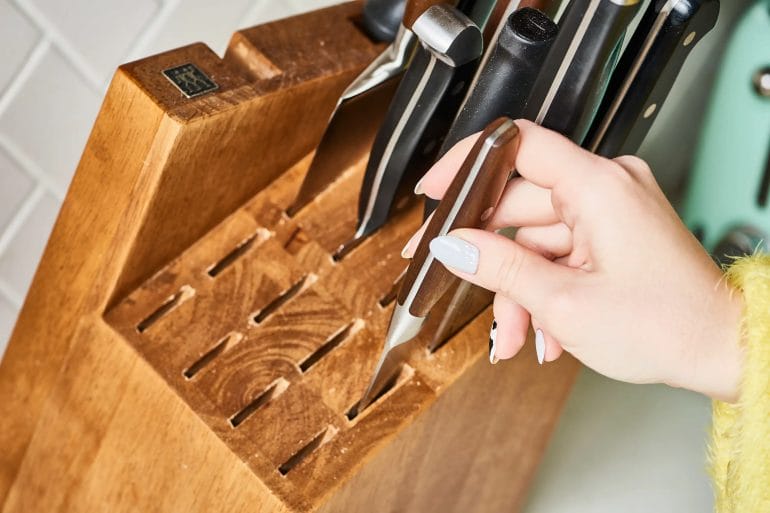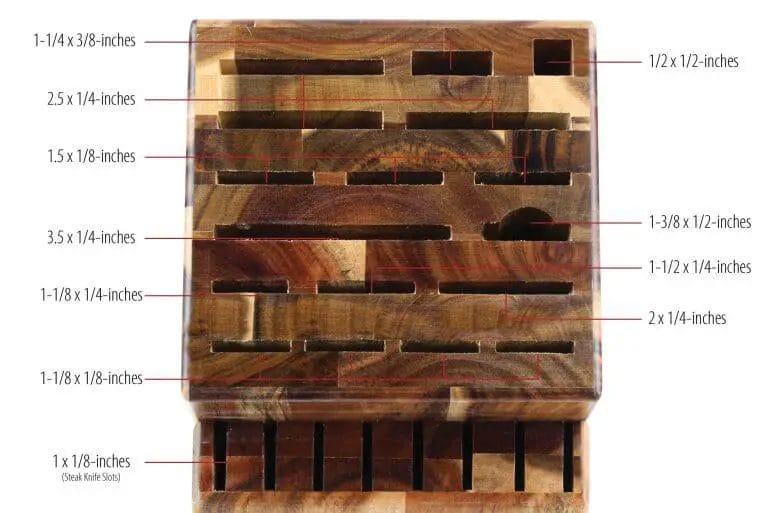Keeping your wood knife block clean is essential for maintaining a hygienic and organized kitchen. Regular cleaning not only prevents cross-contamination but also extends the lifespan of your knives. To clean a wood knife block, start by removing the knives and any loose debris. Then, use a mild soap and warm water solution to gently scrub the block, making sure to reach all the crevices. Rinse thoroughly and allow it to air dry completely before reassembling. Remember to always follow the manufacturer’s instructions for specific care and maintenance.

Removing Stains and Odors from Wood Knife Blocks
Wood knife blocks are a popular choice for storing and organizing kitchen knives. However, over time, they can accumulate stains and develop unpleasant odors. In this section, we will discuss effective methods to remove stains and odors from wood knife blocks, allowing you to keep your kitchen utensils clean and fresh.

1. Deep Cleaning
The first step in removing stains and odors from a wood knife block is to give it a deep clean. Start by removing all of the knives from the block and any debris or food particles that may be present. Next, fill a sink or basin with warm water and mild dish soap.
Submerge the wood knife block in the soapy water and use a soft brush or cloth to gently scrub the surface. Pay extra attention to any stained areas, as well as the interior slots where the knives are stored. Rinse the block thoroughly with clean water and pat it dry with a towel.
2. Removing Stains
If your wood knife block has stubborn stains that did not come off during the cleaning process, there are a few methods you can try to remove them. One option is to create a paste using equal parts baking soda and water. Apply the paste to the stained areas and let it sit for about 30 minutes before rinsing it off.
You can also try using a mixture of vinegar and water to remove stains. Simply dampen a cloth with the solution and gently rub the stained areas. For tougher stains, you can let the vinegar mixture sit on the block for a few minutes before wiping it off.
Another natural stain remover is lemon juice. Squeeze fresh lemon juice onto the stained areas and let it sit for a while before rinsing it off. The acidic properties of lemon juice can help break down the stains and lighten them.
3. Eliminating Odors
If your wood knife block has developed unpleasant odors, there are several methods you can use to eliminate them. One simple way is to place a few activated charcoal briquettes or odor-absorbing sachets inside the block. These will help absorb any lingering odors.
Baking soda is another effective odor remover. Sprinkle some baking soda into the empty slots of the knife block and let it sit overnight. The baking soda will absorb the odors, leaving your block smelling fresh.
Alternatively, you can use a mixture of water and white vinegar to eliminate odors. Fill a spray bottle with equal parts vinegar and water, and spray the solution onto the interior of the knife block. Let it sit for a few minutes before wiping it dry.
4. Regular Maintenance
To prevent stains and odors from building up in your wood knife block, it is important to practice regular maintenance. After each use, make sure to wipe down the block with a damp cloth to remove any food particles or residue.
Additionally, allow the block to air dry completely before storing the knives back in their respective slots. This will help prevent moisture buildup, which can lead to odors and mold growth.
In summary, maintaining a clean and odor-free wood knife block is essential for a hygienic kitchen. By following these tips and techniques, you can effectively remove stains and odors, prolonging the life of your wood knife block and ensuring the safety of your kitchen knives.

Proper Maintenance Tips for Wood Knife Blocks
Wood knife blocks are not only a convenient storage option for your knives, but they can also add a touch of elegance to your kitchen countertop. To ensure the longevity and functionality of your wood knife block, proper maintenance is essential. In this section, we will discuss some useful tips to keep your wood knife block in excellent condition.
1. Regular Cleaning
To maintain the hygiene of your wood knife block, it is crucial to clean it regularly. Start by removing all the knives from the block. Then, using a soft brush or a damp cloth, gently scrub the interior and exterior of the block to remove any dust, debris, or food particles. Ensure that the block is completely dry before placing the knives back in.
2. Proper Drying
Moisture is the biggest enemy of wood, so it’s crucial to ensure that your wood knife block is thoroughly dried after cleaning. Avoid placing the block in direct sunlight or near a heat source, as this can cause the wood to warp or crack. Instead, allow the block to air dry in a well-ventilated area before reassembling the knives.
3. Regular Oil Treatments
To maintain the natural beauty and moisture content of the wood, it is recommended to treat your wood knife block with food-grade mineral oil or cutting board oil. Apply a thin layer of oil to the entire surface of the block, including the slots for the knives. Allow the oil to penetrate the wood for a few hours or overnight, then wipe off any excess oil with a clean cloth. Repeat this process every few months or as needed.
4. Avoid Excessive Moisture
Avoid exposing your wood knife block to excessive moisture, as it can lead to mold or mildew growth. Always wipe off any excess moisture from the knives before placing them back into the block. Additionally, avoid storing wet knives in the block, as the moisture can seep into the wood and cause damage over time.
5. Protect from Heat and Direct Sunlight
Wood is sensitive to heat and direct sunlight, which can cause the color to fade or the wood to warp. To protect your wood knife block, avoid placing it near stovetops, ovens, or windows where it may be exposed to excessive heat or direct sunlight. Instead, find a cool and shaded spot on your countertop to keep the block.
6. Avoid Harsh Cleaning Agents
When cleaning your wood knife block, avoid using harsh cleaning agents or abrasive materials that can damage the surface of the wood. Stick to mild dish soap or a vinegar-water solution to remove any stubborn stains or odors. Gently scrub the block with a soft brush or cloth, then rinse and dry thoroughly.
7. Regular Inspections
Regularly inspect your wood knife block for any signs of damage, such as cracks, splintering, or loose slots. If you notice any issues, address them promptly to prevent further damage. For minor cracks, you can apply wood filler and sand it down to restore the block’s integrity. For more significant damage, it may be necessary to replace the block.
In summary, proper maintenance is essential for keeping your wood knife block in optimal condition. Regular cleaning, proper drying, oil treatments, avoiding excessive moisture and heat, using gentle cleaning agents, and conducting regular inspections will help extend the lifespan of your wood knife block and ensure the safety of your knives.

Best Practices for Cleaning and Sanitizing Wood Knife Blocks
Wooden knife blocks are not only functional but also add a touch of elegance to your kitchen. However, with regular use, they can accumulate dirt, food particles, and bacteria. To ensure the longevity and hygiene of your wood knife block, it is crucial to clean and sanitize it regularly. In this section, we will discuss the best practices for cleaning and sanitizing wood knife blocks.
1. Regular Cleaning
Regular cleaning is the first step in maintaining a clean and hygienic wood knife block. Follow these steps:
- Empty the knife block: Remove all knives from the block and set them aside.
- Remove debris: Tap the block upside down to remove any loose debris or crumbs that may have accumulated inside.
- Scrub the interior: Use a small brush, such as a toothbrush, to scrub the interior walls of the knife block. Pay close attention to the knife slots and corners where bacteria may hide.
- Wipe down the exterior: Use a damp cloth or sponge to wipe down the exterior of the block. Be careful not to saturate the wood with excessive water.
- Dry thoroughly: Allow the block to air dry completely before returning the knives.
2. Deep Cleaning
Deep cleaning should be done periodically to remove stubborn stains and eliminate bacteria that may have penetrated into the wood. Here’s how:
- Follow steps 1 and 2 from regular cleaning.
- Create a cleaning solution: Mix equal parts white vinegar and water in a bowl or container.
- Soak and scrub: Dip the toothbrush or a brush with soft bristles into the cleaning solution and scrub the interior of the knife block thoroughly. Make sure to reach all the nooks and crannies.
- Rinse with clean water: Rinse the block with clean water to remove any vinegar residue.
- Dry thoroughly: Allow the block to dry completely before placing the knives back in.
3. Sanitizing
Sanitizing the wood knife block is essential to eliminate harmful bacteria and ensure a hygienic environment for your knives. Follow these steps:
- Prepare a sanitizing solution: Mix one tablespoon of bleach with one gallon of water in a sink or basin.
- Submerge the block: Place the knife block in the sink or basin, ensuring that it is fully submerged in the sanitizing solution.
- Let it soak: Allow the block to soak for at least five minutes to ensure thorough sanitization.
- Rinse thoroughly: After soaking, rinse the block with clean water to remove any bleach residue.
- Air dry: Allow the block to air dry completely before reinserting the knives.
4. Maintenance Tips
In addition to regular cleaning and sanitizing, here are some maintenance tips to keep your wood knife block in top condition:
- Keep it dry: Avoid placing wet or damp knives into the block to prevent moisture from seeping into the wood.
- Avoid direct sunlight: Keep the knife block away from direct sunlight, as prolonged exposure can cause the wood to fade or crack.
- Reapply oil: Periodically apply food-safe mineral oil or butcher block conditioner to keep the wood moisturized and prevent it from drying out or splitting.
- Store knives properly: Insert the knives into the slots carefully to avoid damaging the blades or scratching the interior of the block.
In summary, cleaning and sanitizing your wood knife block regularly is essential to maintain its functionality and hygiene. By following these best practices, you can ensure that your knife block remains clean, free from bacteria, and prolong its lifespan. Incorporate these practices into your kitchen cleaning routine to keep your wood knife block in optimal condition for years to come.
Expert Tips for Prolonging the Lifespan of Your Wood Knife Block
Wooden knife blocks are not only functional but also add a touch of elegance to your kitchen countertop. To ensure that your wood knife block lasts for years to come, it requires proper care and maintenance. Here are some expert tips to help you prolong the lifespan of your wood knife block:
1. Clean the Block Regularly
Regular cleaning is essential to prevent the buildup of dirt, food particles, and bacteria on your wood knife block. After each use, wipe the block with a damp cloth to remove any residue. Avoid using harsh chemicals or abrasive cleaners, as they can damage the wood. Instead, use a mild soap and warm water solution to gently clean the surface.
2. Dry Thoroughly
Moisture is the enemy of wood, so it’s crucial to dry your knife block thoroughly after cleaning. Use a clean towel to remove any excess water and allow the block to air dry completely before returning your knives. This helps prevent the growth of mold or mildew, which can damage the wood and compromise its integrity.
3. Oil the Wood
Wood is a natural material that can dry out over time, leading to cracks or splits. To keep your wood knife block moisturized and prevent it from drying out, it’s recommended to oil the wood regularly. Use food-grade mineral oil or specialized wood oil and apply a thin layer using a soft cloth. Let the oil penetrate the wood for a few hours, then wipe off any excess oil.
4. Keep Knives Clean and Dry
Before placing your knives back into the wood block, make sure they are clean and dry. Any moisture or food residue on the knives can transfer to the block and cause damage. Wash your knives by hand, dry them thoroughly, and only return them to the block once they are completely dry.
5. Avoid Excessive Heat and Sunlight
Exposure to excessive heat or sunlight can cause the wood to warp or fade over time. It’s best to keep your wood knife block away from direct sunlight and heat sources like stovetops or ovens. Find a cool and dry spot in your kitchen to store the block and ensure its longevity.
6. Rotate and Rearrange Knives
Rotating and rearranging your knives within the block can help distribute the weight evenly and prevent excessive wear on specific slots. This also allows any moisture trapped between the knives to evaporate and reduces the risk of bacteria growth. Consider rearranging your knives every few months to promote even usage and prolonged lifespan of the wood block.
7. Avoid Cutting Directly on the Block
While wood is durable, it’s not designed to withstand the force and pressure of cutting on its surface. Avoid using the knife block as a cutting board to prevent scratches, dents, and potential damage to both your knives and the block itself. Always use a proper cutting board for your cutting needs.
8. Refinish When Needed
If you notice significant wear, stains, or scratches on your wood knife block, consider refinishing it to restore its beauty and functionality. Sanding the surface and applying a fresh layer of food-safe finish can help revive the block and protect it from further damage. Follow the manufacturer’s instructions or consult a professional for best results.
In summary, taking proper care of your wood knife block is essential to ensure its longevity. Regular cleaning, drying, oiling, and avoiding excessive heat or direct sunlight are key factors in maintaining its beauty and functionality. By following these expert tips, you’ll be able to enjoy the benefits of your wood knife block for years to come.
FAQs
How do I clean a wood knife block?
To clean a wood knife block, start by removing all the knives. Then, use a damp cloth or sponge to wipe down the interior and exterior of the block. Avoid using excessive water or soaking the block as it can damage the wood. Allow the block to air dry completely before placing the knives back in.
Conclusion
In conclusion, maintaining the cleanliness of your wood knife block is essential for both hygiene and longevity. By following a few simple steps, you can easily clean and care for your knife block. Regularly removing the knives, wiping down the block with a damp cloth, and thoroughly drying it will help prevent the growth of bacteria and mold. Additionally, using a food-safe disinfectant spray or a mixture of vinegar and water can further sanitize the block. Remember to oil the wood occasionally to keep it moisturized and prevent cracking. By taking these measures, you can ensure a clean and safe kitchen environment while prolonging the life of your wood knife block.